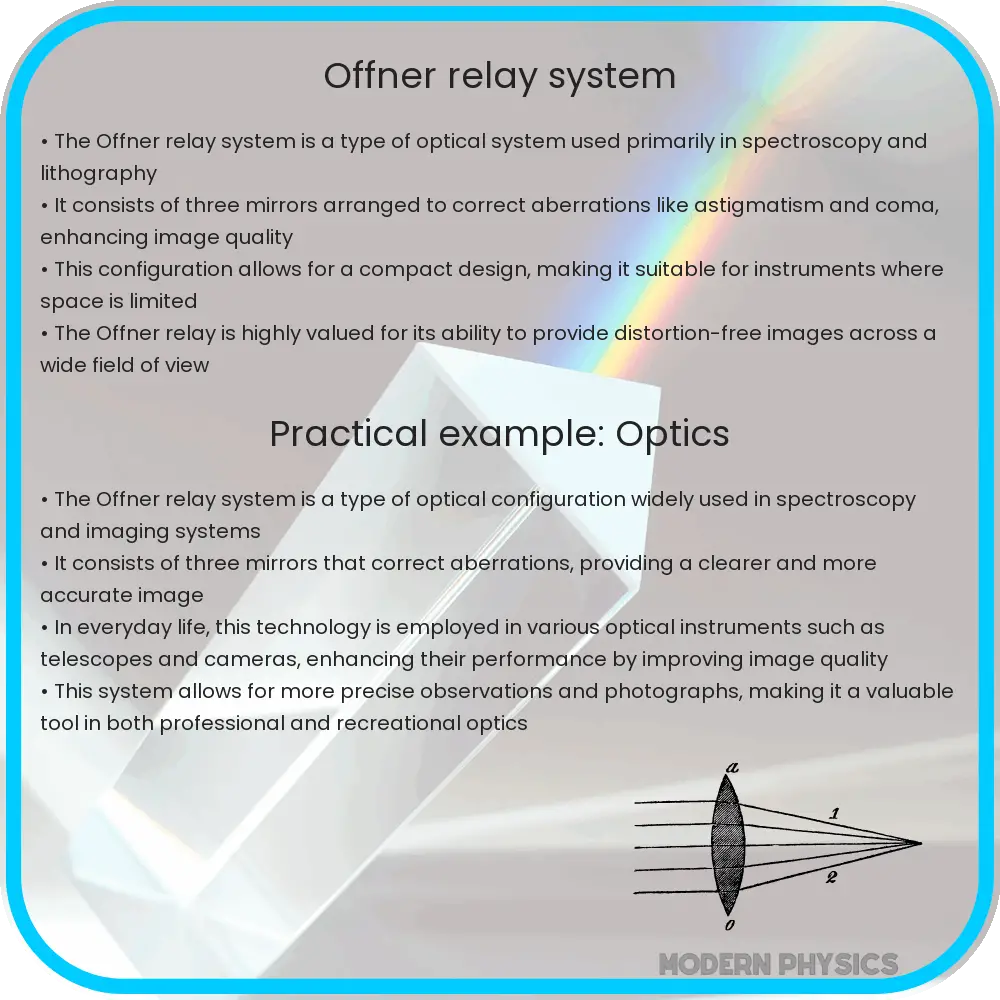Discover the Offner Relay System: a breakthrough in optical design, offering unmatched clarity and precision for advanced imaging applications.

The Offner Relay System: Unveiling the Marvels of Optical Engineering
The Offner Relay System, a pivotal innovation in the realm of optical engineering, stands out for its remarkable clarity, precision, and design. This ingenious configuration, conceived by American physicist Adolf Offner in the late 20th century, has revolutionized the way high-resolution imaging systems are conceptualized and implemented. At its core, the Offner Relay is a reflective optical system that employs a concave spherical mirror in a unique configuration to achieve aberration-free imagery over a wide field of view, making it a cornerstone in applications ranging from lithography to astronomical telescopes.
Design Principles and Operational Mechanics
The brilliance of the Offner Relay lies in its simplicity and efficiency. The system is designed around a central concave mirror, accompanied by a smaller convex mirror placed in such a way that it mirrors the curvature and alignment of the larger one. This arrangement creates a 1:1 imaging system that inherently cancels out aberrations such as coma, distortion, and spherical errors, which are common challenges in optical systems. The precision in the Offner Relay’s design allows for exceptional clarity in the images produced, making it indispensable for precision-dependent fields.
Applications and Impact
The Offner Relay System’s adaptability and performance have paved the way for its integration into a multitude of high-tech applications. In the field of lithography, especially in the manufacturing of semiconductors, the Offner Relay’s ability to produce distortion-free images is critical for achieving the nanometer precision required in chip designs. Similarly, its use in satellite imaging systems ensures the capture of high-resolution photographs from space, aiding in environmental monitoring, mapping, and surveillance. The system’s nonpareil precision and clarity also make it a preferred choice in the design of astronomical telescopes, where capturing detailed images of distant celestial bodies is paramount.
Furthermore, the Offner Relay’s unique design has inspired advancements in optical engineering, leading to the development of more compact, efficient, and accurate imaging systems. Its influence extends beyond immediate applications, contributing to the broader field of optical science through innovations in design principles and the exploration of new materials and technologies. The Offner Relay System, with its unmatched clarity, precision, and elegantly simple design, continues to be a beacon of excellence in optical engineering.
Understanding the Offner Relay System
The Offner relay system is a remarkable feat of optical engineering, renowned for its ability to provide unparalleled clarity and precision in imaging applications. This optical system, based on a configuration proposed by American physicist A. Offner, has found extensive use in a variety of high-resolution imaging devices, including spectrographs, telescopes, and lithography equipment. Its design principles emphasize simplicity, efficiency, and the minimization of optical aberrations, making it a cornerstone in advanced optical engineering.
Core Design Features
At the heart of the Offner relay system is a concave mirror that serves as the primary imaging component. This mirror is cleverly positioned to reflect and focus light, creating an image with extraordinary sharpness and detail. The system’s unique configuration allows it to correct chromatic aberration—a common problem in optical systems where different wavelengths of light do not converge at the same point—thereby producing images of superior quality. Additionally, the Offner relay is celebrated for its compact size, offering a significant advantage in applications where space is at a premium.
Applications and Impact
The Offner relay system’s precise imaging capabilities have made it a staple in fields requiring high-resolution imagery. In astronomy, it enhances the ability to observe distant celestial bodies with remarkable clarity. In the semiconductor industry, its application in photolithography equipment enables the production of microchips with ever-smaller features, pushing the boundaries of Moore’s Law. Moreover, its use in spectroscopy aids in the detailed analysis of materials by accurately imaging the spectrum of light they emit or absorb.
Conclusion
The Offner relay system represents a pinnacle of optical design, offering unmatched clarity and precision in a compact form factor. Its application across various scientific and industrial fields underscores its versatility and the critical role it plays in advancing technology. By minimizing optical aberrations and efficiently managing light, the Offner relay system has paved the way for significant advancements in imaging, from the depths of space to the intricacies of semiconductor devices. As optical technology continues to evolve, the principles underlying the Offner relay system will undoubtedly inspire future innovations, further extending the frontiers of clarity and precision in imaging.
